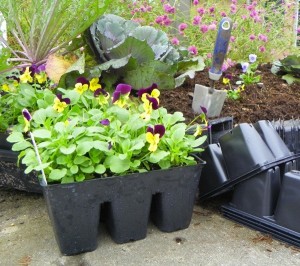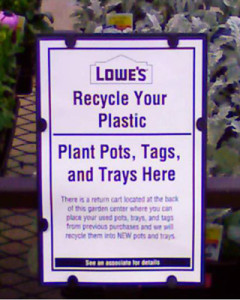Recycling Plastic Plant Pots and Containers
go.ncsu.edu/readext?251856
en Español / em Português
El inglés es el idioma de control de esta página. En la medida en que haya algún conflicto entre la traducción al inglés y la traducción, el inglés prevalece.
Al hacer clic en el enlace de traducción se activa un servicio de traducción gratuito para convertir la página al español. Al igual que con cualquier traducción por Internet, la conversión no es sensible al contexto y puede que no traduzca el texto en su significado original. NC State Extension no garantiza la exactitud del texto traducido. Por favor, tenga en cuenta que algunas aplicaciones y/o servicios pueden no funcionar como se espera cuando se traducen.
Português
Inglês é o idioma de controle desta página. Na medida que haja algum conflito entre o texto original em Inglês e a tradução, o Inglês prevalece.
Ao clicar no link de tradução, um serviço gratuito de tradução será ativado para converter a página para o Português. Como em qualquer tradução pela internet, a conversão não é sensivel ao contexto e pode não ocorrer a tradução para o significado orginal. O serviço de Extensão da Carolina do Norte (NC State Extension) não garante a exatidão do texto traduzido. Por favor, observe que algumas funções ou serviços podem não funcionar como esperado após a tradução.
English
English is the controlling language of this page. To the extent there is any conflict between the English text and the translation, English controls.
Clicking on the translation link activates a free translation service to convert the page to Spanish. As with any Internet translation, the conversion is not context-sensitive and may not translate the text to its original meaning. NC State Extension does not guarantee the accuracy of the translated text. Please note that some applications and/or services may not function as expected when translated.
Collapse ▲Fall is planting time; for pansies, perennials, trees, and shrubs, fall is the best time to plant in the south. But there is a problem. Almost every plant you purchase comes in a plastic pot. After the plant is in the ground, you are left wondering what to do with the pot. Don’t just throw it in the landfill, where it will join the thirty million tons of plastics Americans dispose of each year. There are better options! Keep pots and other types of plastic out of the landfill by recycling.
Local Recycling Options
Recycling plastic pots, packs, and flats that plants are grown in is not always as simple as recycling soda and water bottles. Plastic drink bottles marked with the recycling code 1 are made of PET plastic, one of the most easily recycled types of plastic. Nursery and greenhouse pots are made from other types of plastic, including high density polyethylene, known as HDPE and marked with recycling code 2; polypropylene, marked with recycling code 5; and polystyrene, marked with recycling code 6. While every town and county recycling program in our area accepts PET or code 1 plastic, fewer accept the types of plastic from which plant pots are made.
A check of county websites in our area showed that New Hanover and Brunswick counties accept plastics that are clearly marked with recycling codes one through seven at their convenience centers, while Pender only accepts plastic bottles with codes one or two. Most towns in our area also only accept plastic bottles with the recycling code one or two, though the Town of Burgaw and City of Wilmington both accept plastic types one through seven. If you are not sure which types of plastic your municipality accepts, check their website or call your local public works department. Don’t give up if your plastic containers are not clearly marked with a recycling code or if your town or county will not accept them, there are other local options.
Take Them to Lowe’s
In 2011, Lowe’s launched a nationwide program to accept plastic plant pots, flats, and packs for recycling at their stores, including the six Lowe’s locations in our region. Plastics that are returned to North Carolina Lowe’s stores are sent to Metrolina Greenhouses, just outside of Charlotte, NC. Metrolina is one of the largest greenhouse operations in the United States and a major supplier of Lowe’s plants.
Once the plastics arrive at Metrolina, they are sorted by plastic type. Pots and containers that can be reused are cleaned and put back into production. Those that cannot be reused are shredded and sent to a recycler. Some of the plastics are used to make new plant containers while others are used to produce plastic landscape timbers and other outdoor plastic items. Plant pots and containers are not recycled into drink bottles or other PET plastic items.
Take Them to a Nursery
Lowe’s is not the only place that will accept plastic plant pots and containers. Many local nurseries will reuse plastic pots if you return them. I called a few in our area, including Tinga Nursery in Castle Hayne, Pender Pines in Hampstead, and Phillips Nursery in Leland. All said that would gladly take back gallon size pots and larger (these are the type of containers perennials, trees and shrubs are grown in), but they are not able to use plastic six packs or pots that annuals and vegetables were grown in. Your best option for recycling these is Lowe’s.
Reuse at Home
You can also reuse plastic pots for your own gardening. Larger pots, such as three or five gallon containers, are particularly useful for growing vegetables. Save four and six packs to start seedlings or root cuttings. Hanging baskets can be replanted with new plants in future years. Since plant diseases such as root rot can survive on pots from year to year, it is recommended you wash and sanitize pots before reusing them by first scrubbing off any soil or plant debris and then soaking the pots for at least thirty minutes in a ten percent bleach solution, which can be made by mixing nine parts water to one part bleach. After pots are cleaned, store them somewhere off the ground until you are ready to use them.
Learn More
Visit your local Cooperative Extension office to learn more about gardening and landscape care. Go to https://www.ces.ncsu.edu/local-county-center/ to find your county Extension center.
- If you live in Pender County, call 910-259-1238
- In New Hanover County, call 910-798-7660
- In Brunswick County, call 910-253-2610
- In Onslow County, call 910-455-5873
- In Duplin County, call 910-296-2143





